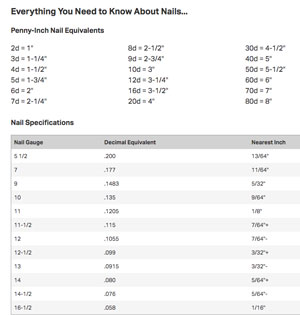There are two explanations for the English “penny” system of designating nail lengths. One is that the eight penny, six penny, two penny nails, etc. were so-called originally because one hundred nails cost eightpence, sixpence, twopence, etc. The other theory says that one thousand eight penny nails, for example, weighed eight pounds, one thousand four penny nails weighed four pounds, etc.

The “d” abbreviation for penny (8d for example) is of ancient origin and represents the first letter of the Roman coin denarius.
Nails used for wood-to-wood applications (such as wood siding nails, cedar shingle nails, etc.) are traditionally referred to by the “penny” designation, i.e., 5d or 6d nails, etc. However, nails for non-wood applications, fiber-cement siding nails, metal roofing nails, etc., are primarily referred to by inches, i.e., 1 1/2” or 2” nails, etc.
There is no readily apparent system for correlating the various penny nail designations. They must be memorized individually. GSCB






















